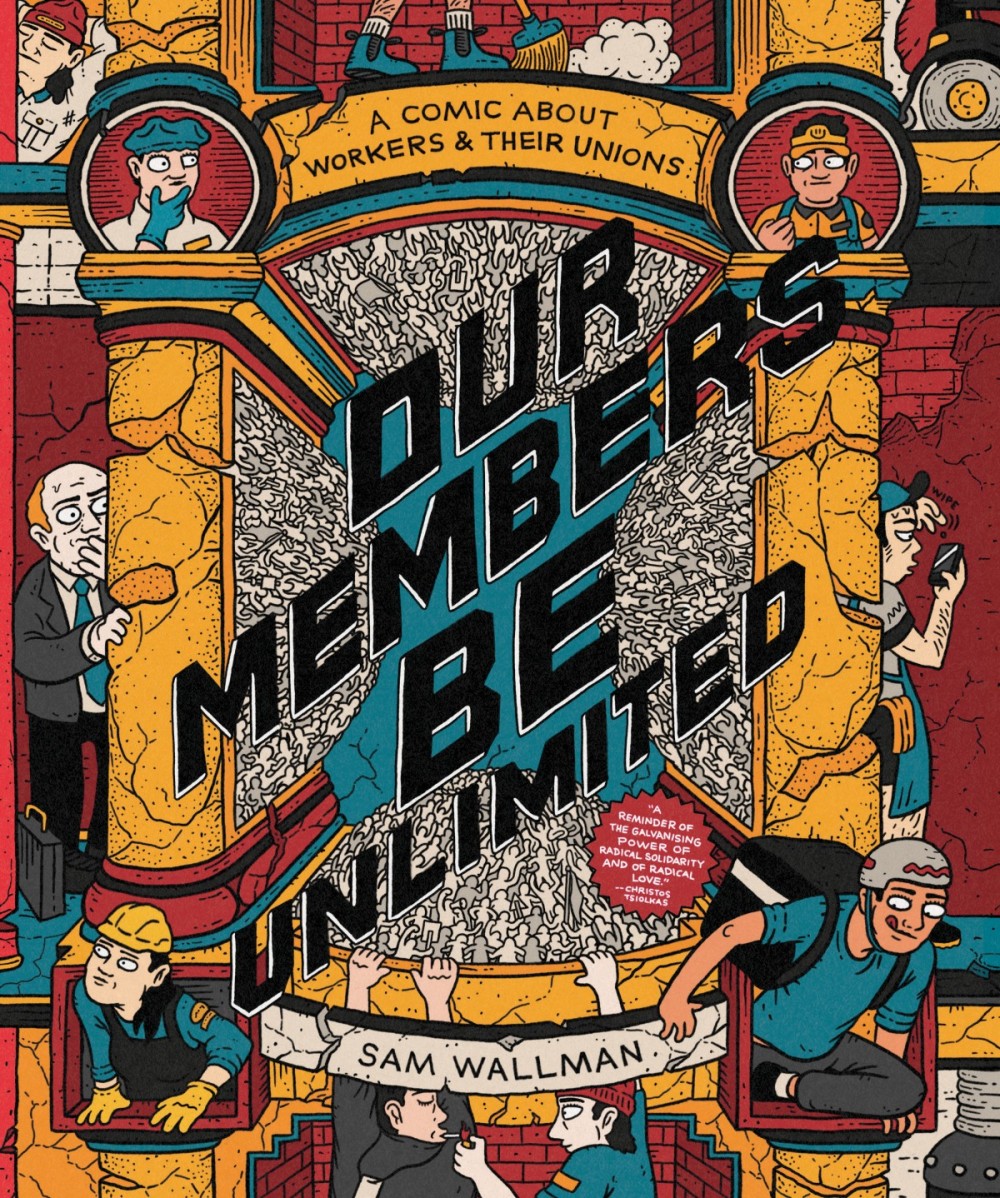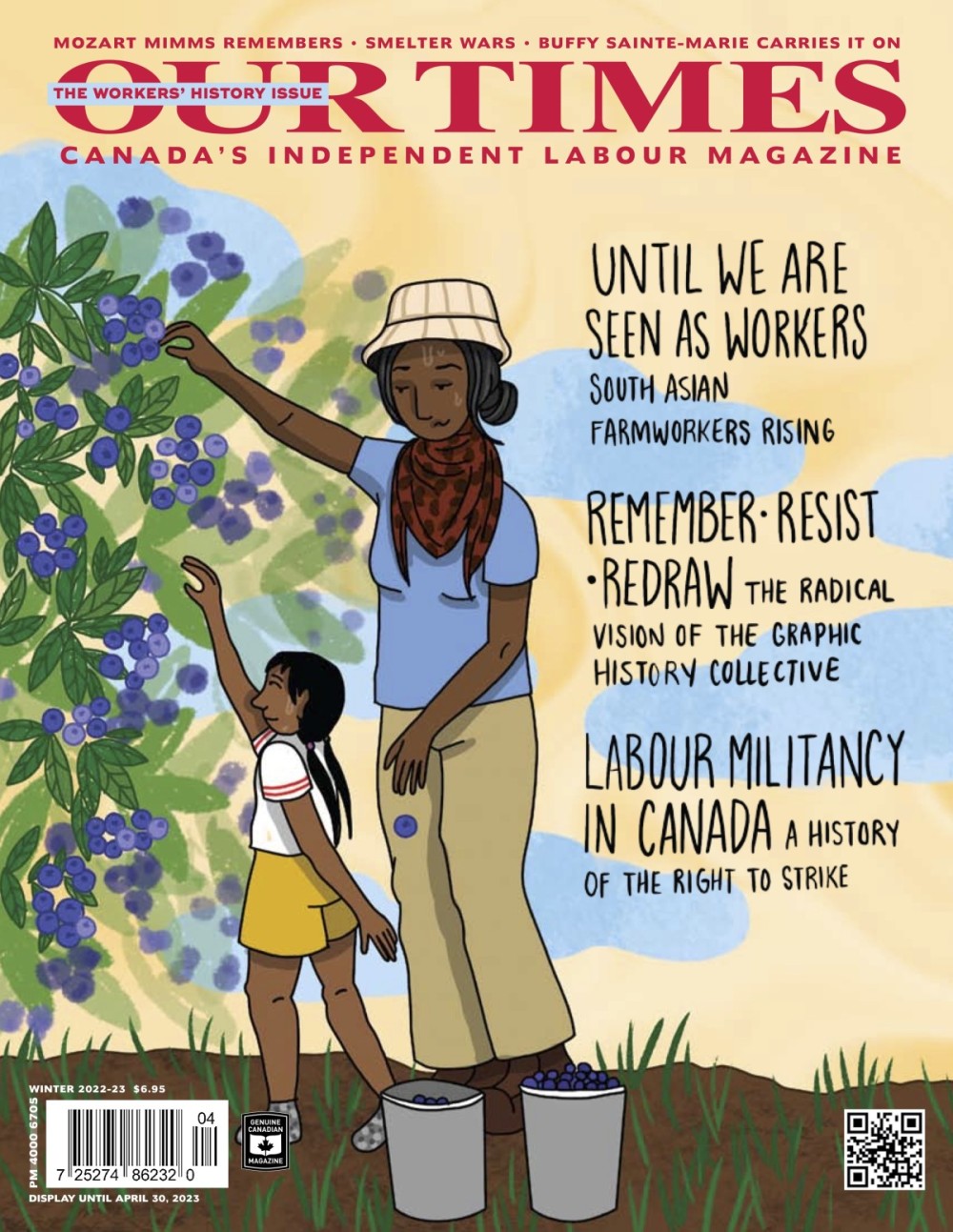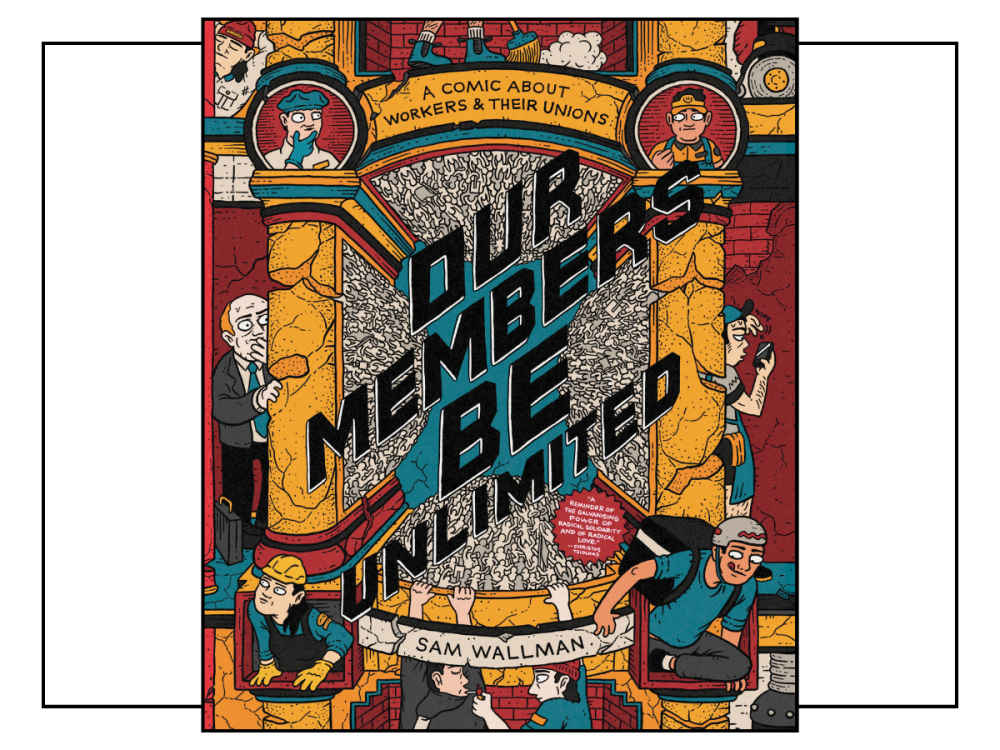What are the uses of labour history? Our Members Be Unlimited, by Melbourne-based cartoonist Sam Wallman, is an engaging visual exploration of the history of unions and why they matter.
Wallman’s graphic novel starts by tracing the origins of early worker organizations in Britain, with moonlit figures coming together under the cover of night to swear secret oaths of allegiance. Some of the predecessors of today’s unions were clandestine groups, operating outside the bounds of what was permitted by the law. Under Britain’s Combination Acts of 1799 and 1800, any “combined” efforts by workers to organize for an increase in wages, a decrease in hours, or to solicit anyone to leave work were made illegal, and punishable by three months in jail or two months of hard labour.
The Tolpuddle Martyrs, six farmworkers so-named because they were sentenced to seven years in the penal colonies of Australia for forming a “friendly society” in 1834, were returned to England after two years of unrest and mass protests demanding their freedom.

Our Members Be Unlimited: a comic about workers and their unions. By Sam Wallman. Scribe, 2022. 256 pages. $39.99. ISBN (13):9781925713053.
The book’s title is drawn from the first rule of an early English working-class organization which decreed that “the number of our members be unlimited.” Citing E.P. Thompson’s classic The Making of the English Working Class (1963), Wallman notes that this was a “wildly inclusive” idea in a context where only three per cent of the population could vote, with such political rights the exclusive domain of property owners.
His account provides a timely reminder about the non-legal roots of unions during a moment when we find workers’ basic statutory rights increasingly being trampled by intransigent employers and governments who demand docility and compliance. In addition to being a comics journalist, Wallman is a committed trade unionist who has worked as a union organizer and an elected workplace rep on the shop floor. The second and perhaps most gripping chapter of the book provides a window into the realities of an Amazon warehouse in Melbourne where Wallman worked as a picker for a year.
Initially marvelling at the scale and cold efficiency of the massive operation, Wallman describes the rapid pace of the work and the toll it takes on his mind and body. In one panel, he illustrates his arms melding with the tools of the trade, asking “Is the cart I push an extension of my body?” He continues, as layers of skin peel back to reveal bone:
After a while, I start to get tired / The kind of tired that you feel in your bones / the kind that even a good night’s rest can’t fix / There’s a feeling in the upper part of my gut, one I didn’t have before I started here / I can’t tell if the root of it is emotional or physical / Maybe it’s spiritual.
While working in the panoptic warehouse, Wallman and his colleagues form bonds of friendship and find ways to support each other through their taxing workdays. There are glimpses of hope in one-to-one organizing conversations — and a defiant moment of direct action, but any collective momentum remains difficult to sustain amid the constant staff turnover, which, of course, is by design.
Reflecting on what the future may hold, Wallman observes that workers have organized themselves from much weaker positions historically. Rather than yearning for a more radical past, in another chapter Wallman channels American Marxist Harry Braverman, who said his views about work were “governed by nostalgia for an age that has not yet come into being.” A wraith-like figure gives voice to Braverman’s words while turning giant pages on a spectral plane. Elsewhere, Wallman quotes Indian Marxist commentator Vijay Prashad on the historian as a magpie in the ruins, visiting the past “not as a destination but as a resource,” to see what shines.
This is not a linear read. With his bold palette of earth tones and pages packed with intricate details, Wallman takes us on divergent paths, shifting visual and narrative approaches chapter-by-chapter to provide unique insights on the state of the labour movement. While there are references to events in China, India, Bangladesh, Haiti, and even outer space, most of the examples concern England, Australia, and to a lesser degree the United States.
The characters in Wallman’s slightly feverish drawings call to mind the line-work of The Simpsons creator Matt Groening and, when boiled down to more abstract figures, New York street artist Keith Haring. Walt Disney, a canonical figure in the history of sequential art, makes an appearance for his attempts to thwart the efforts by his animators to unionize.
Our Members Be Unlimited touches on a number of pressing issues which are ripe for further discussion and debate by union activists.

This article is from our Winter 2022-2023 Workers’ History Issue. Head to ourtimes.ca/magazine to see what’s in the latest issue.
Wallman celebrates the power of an intersectional approach that is inclusive of all the different experiences and identities that make up working-class communities.
Using a backdrop of linked arms, downed tools, and other forms of practical solidarity, he recounts the story of Terry Stokes, a Melbourne University student who was arrested in 1979 for kissing his lover outside a pub and expelled from his campus housing.
A mass kiss-in was followed by a strike threat by the university’s cafeteria workers, resulting in Terry being invited back.
In a similar spirit of unity, Wallman depicts the unruly Battle of Cable Street where a fascist march through East London’s Jewish neighbourhood in 1936 was blocked by a massive demonstration drawing together people from all corners of London and beyond: dockers, cabinet-makers, sailors, miners, Irish Catholic women, communists, and many others.
Solidarity is expressed in more conceptual terms in other passages. Wallman relates the enormous underground network of the largest organism on Earth — a species of fungi — to the refusal by dockers at ports around the world to unload “hot cargo” from apartheid South Africa. A “seemingly unrelated group” sticking their necks out for each other.
Now, picture many hands contributing an ingredient to a massive cauldron of soup. This is one of Wallman’s depictions of a union — the collective contribution of energy and resources, of people doing their part to nourish each other, in order to make something much larger than the sum of its parts.
Just the same, unions are a manifestation of conflict. They are the result of contestation between the working class and ruling class, but also among workers with differing visions of the way forward. As early unions built power and sought legal protections from the state, such forms of legitimacy could be double-edged, says Wallman, in that they also “hemmed in” unions and their repertoires of dissent. In a coffee shop conversation with a friend, surrounded by a moving tapestry of working-class life, Wallman and his interlocutor discuss three interrelated obstacles: the bosses, conservative union leaders, and disunity within the working class itself.
We know that workers build their confidence by taking action, and that when we take action together, we can make history. But there are no guarantees. When we consider the growth of precarious employment and rapid development of the platform economy, one dystopic vision of the future of work looks a lot like the very familiar, unchecked exploitation workers have fought so hard to extinguish over many generations.
For Wallman, new forms of technology are not inherently bad for workers. What matters are the priorities we set as a society. He looks to Amazon’s plans for fully automated warehouses and notes that a Japanese robotics company has been running a “lights-out” factory since 2001, supposedly unsupervised for up to 30 days at a time. And yet, we know that new technologies (which are often overhyped) will always create demand for new jobs, requiring new forms of specialized labour. Wallman wonders whether those who fill these roles will be the artisans of the future. Will they have a sense of their collective power, as potential choke points in supply chains?
This is one of the many uses of labour history — to give us an understanding of who we are, where we come from, and who we might be. Our Members Be Unlimited is advertised as an entry point for younger generations and a stirring reminder for all trade unionists. Wallman’s distinctive style and outlook make for a fun read, and are nuanced enough to be a good starting point for union educational activities and discussions.
This book is a welcome addition to the growing output of graphic novels about labour, including the titles edited by the Graphic History Collective and published by Between the Lines, such as Drawn to Change: Graphic Histories of Working-Class Struggle (2016), and other contributions like Wobblies! (2005), the graphic history of the Industrial Workers of the World edited by Paul Buhle and Nicole Schulman.
As a visual medium, graphic novels add a new dimension to storytelling and are easier to pick up and fit into our fast-paced lifestyles — at least for this reader. Wallman’s book is worth ordering to appreciate it in full — and then share with a fellow worker — but for anyone who wants to get a head start, the chapter on Amazon has been excerpted and made available online by The Guardian.
Ryan Hayes is a trade unionist and former board member with the Mayworks Festival of Working People and the Arts in Toronto. He recently relocated to London, England to work for a global union federation.











